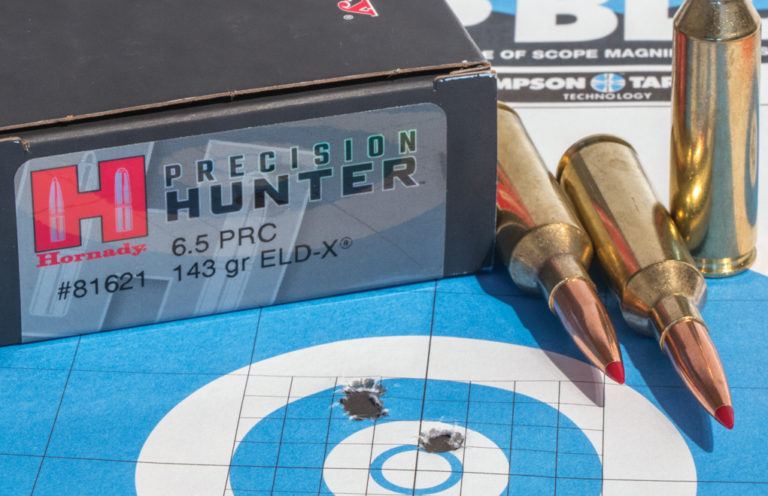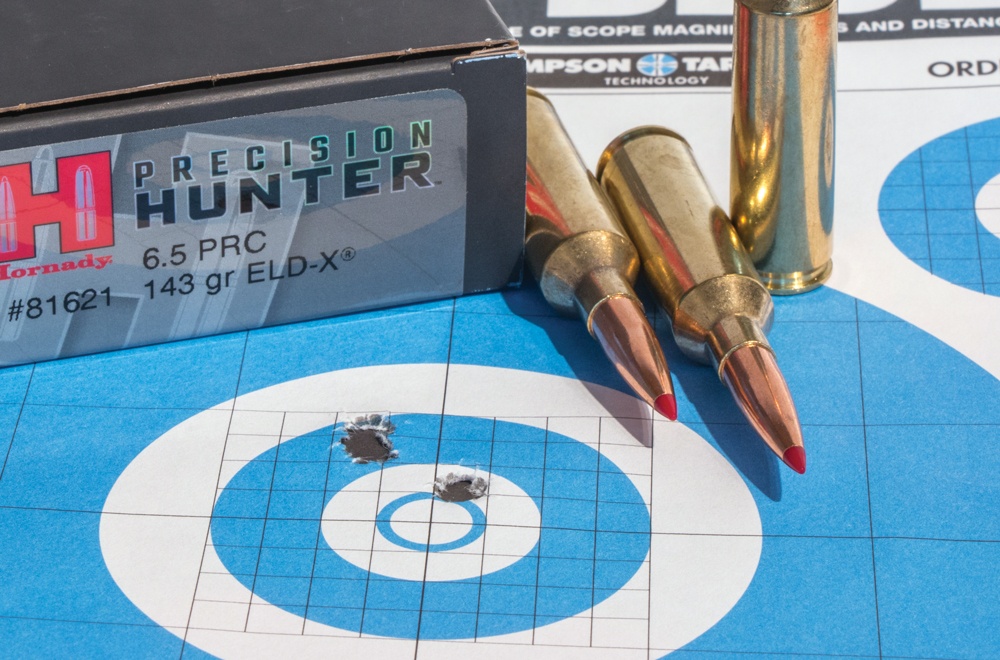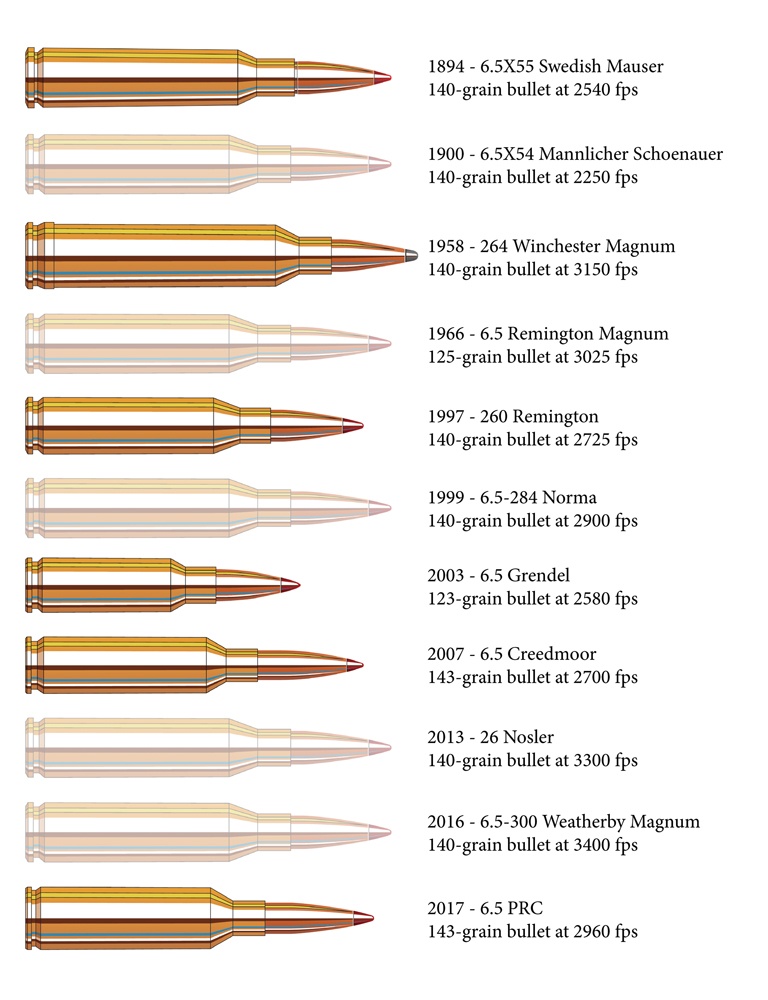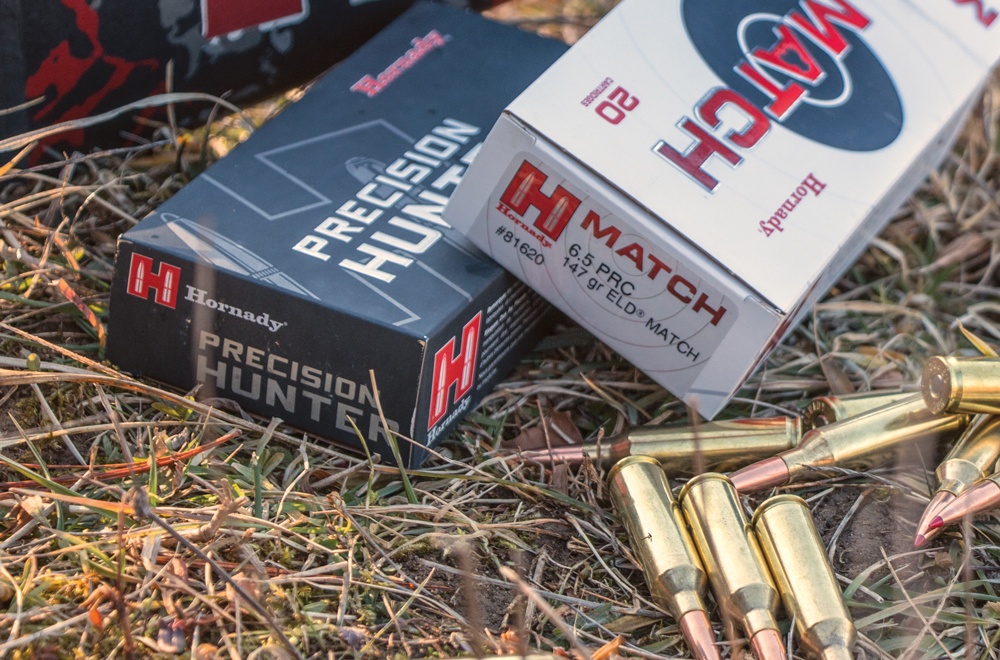
The 6.5 PRC is Hornady’s new hot shot and looks to have ballistic chops to be be the No. 1 six.
How does Hornady’s new 6.5 PRC measure up?
- It is based on the Ruger Compact Magnum case.
- The 6.5 PRC has 28 percent more capacity than the 6.5 Creedmoor.
- This adds up to an 8-percent increase in velocity.
- The round performs best out of its SAAMI specified 1:8 twist barrel.
- It offers a great balance between power, trajectory and recoil.
Riflemen continually look to extend their reach with better ballistics. In fact, if we look at rifle cartridge development during the past century, the ability to deliver more power on target, with bullets that shoot flatter, has been the driving force. The ultimate expression of better ballistics comes when additional power and flatter trajectory are balanced with tolerable recoil. This is why the new 6.5 PRC cartridge from Hornady is such a big deal.

Many consumers and wannabe gun experts only think new cartridges are a means for manufacturers to sell more guns and more ammo. About the same number of shooters are also so emotionally attached to a certain cartridge that they cannot accept — nor will they acknowledge — something better has come along.
And, too, there’s this thing called neophobia, which is an extreme or irrational fear or dislike of anything new, novel or unfamiliar. For all of these reasons, some shooters are completely ignoring or bashing the 6.5 PRC.
The 6.5 PRC cartridge is based on the Ruger Compact Magnum case. It has a 0.532-inch rim diameter, a 2.030-inch case length, a 30-degree shoulder and an overall cartridge length of 2.955 inches. Its case capacity is about 28 percent more than the 6.5 Creedmoor, and the 6.5 PRC will push a 143-grain ELD-X bullet to about 2,960 fps. This is 260 fps faster than the 6.5 Creedmoor, which is an increase of about 8 percent. Given its 65,000 psi operating pressure, as compared to 62,000 for the Creedmoor, this is consistent with a velocity gain of about one-fourth the percentage of capacity increase.
To understand the significance of the new 6.5 PRC cartridge from Hornady, you must first understand the history of 6.5mm cartridges. Until the Creedmoor, a 6.5mm (0.264-caliber) cartridge has never gained widespread popularity in America. Even then, it took nearly a decade for shooters to understand the subtle but important advantage the Creedmoor offered. Here’s a chronological look at the most well-known and mostly unloved, 6.5mm rifle cartridges.
The 6.5 Timeline

(Muted cartridges are not to scale.)
1894: 6.5×55 Swedish Mauser
Jointly developed by Norway and Sweden as a military cartridge, up until the mass acceptance of the 6.5 Creedmoor, it was the most popular 6.5mm cartridge worldwide. It will drive a 140-grain bullet to 2,540 fps and has probably killed more Scandinavian moose than anything else. However, being a long-action cartridge, it’s ballistically inferior to the .270 Winchester, which was well established before the Swede found its way to America.
1900: 6.5×54 Mannlicher Schonauer
Originally a Greek military cartridge designed for the 1903 Mannlicher, this cartridge and its 140-grain bullet at 2,250 fps became popular in Africa. It was even used there successfully by elephant hunters. It’s been obsolete longer than most readers have been alive.
1958: .264 Winchester Magnum
Based on the belted .458 Winchester Magnum case, the .264 was originally available in a 26-inch barreled Winchester Model 70. Capable of pushing a 140-grain bullet to 3,150 fps, it was initially a hit as a Western hunting cartridge. Ultimately, it could never compete with the milder, more efficient and very popular, .270 Winchester.
1966: 6.5 Remington Magnum
Introduced for Remington’s excellent Model 600 carbine, the rifle’s short barrel would not allow the cartridge to reach its potential. With a longer barrel, you can expect a 120-grain bullet to do 3,025 fps. Its case is long for a short-action cartridge and is not compatible with modern, high ballistic coefficient (BC) 6.5mm bullets in those short actions.
1997: .260 Remington
Supported by the great gun writer Jim Carmichel, this Remington offering found a following with long-range shooters. And, with a 140-grain bullet at 2,725 fps, it sort of bridges the gap between the .243 Winchester and 7mm-08 Remington for hunters. However, in the short-action it was designed for it cannot handle the longer 6.5mm bullets.
1999: 6.5-284 Norma
Based on the excellent .284 Winchester case with its hated rebated rim, this popular and longtime wildcat was legitimized by Norma. However, when loaded for best performance at long range, it needs a 3-inch or longer action to push high BC 140-grain bullets to anything near 3,000 fps. Affordable, non-custom rifles are essentially nonexistent.
2003: 6.5 Grendel
Steadily gaining in popularity, the 6.5 Grendel was specifically designed for the AR-15 platform, where it shines. Based on the 7.62x39mm cartridge case, it only has the capacity to push a 123-grain bullet to about 2,580 fps. These ballistics are exceptional for an MSR, but lacking when compared to other 6.5s.
2007: 6.5 Creedmoor
It took the Creedmoor about 10 years to really catch on. A near ballistic twin to the .260 Remington, the Creedmoor’s shorter case allows for the loading of the longer and higher BC bullets, which makes it, with a high BC 140-grain bullet at about 2,700 fps, superior to the .260 at any real distance.
2013: 26 Nosler
This was the first post-Creedmoor attempt to offer a high performance 6.5mm rifle cartridge. Based on the .404 Jeffrey case, it will drive a 140-grain bullet to a blistering 3,300 fps. It could be considered a .264 Super Magnum, and it kicks and sounds like one.
2016: 6.5-300 Weatherby
The fastest 6.5mm cartridge on the planet, this recent offering by Weatherby can push a 140-grain bullet to almost 3,400 fps. It has a horrid muzzle blast and will eat a barrel’s throat at a rapid rate. As fast as the Nosler and Weatherby are, sales have only been so-so, and ammo is not cheap.
It’s In The Twist
What’s not referenced above, and something that’s most always missed by consumers who immediately damn the introduction of any new cartridge, is twist rate. Granted, twist rate is not a feature of a cartridge — it’s a barrel specification.

But, what many do not know is that when a cartridge is standardized for commercial production and approved by the Sporting Arms and Ammunition Institute (SAAMI), a twist rate is stipulated along with cartridge dimensions and pressure limits. This standardization is what allows any manufacture to build ammunition to work in any commercially produced — SAAMI approved — firearm.
With the exception of the 6.5 Creedmoor, the fastest commercially available twist rate in mass-produced rifles for any of the cartridges listed is 1 in 9, with twist rates for some cartridges even slower. This means those cartridges — when chambered in firearms built to SAAMI specifications like most commercial firearms are — are not capable of handling the newest and very slender, high BC 6.5mm bullets. Yes, a .264 Winchester Magnum can generate higher velocities than a 6.5 PRC. But, unless it has an aftermarket — faster twist — barrel, it will not stabilize those bullets as well.
Built On Balance
Now, you might be getting the picture. While the 6.5 PRC might not be the fastest 6.5mm cartridge on the planet, it’s the current best commercial offering because not only does it have a mandated fast twist-rate (1:8) to handle bullets with a high BC, it offers a great balance between power, trajectory and recoil. And, that balance is something that long-range shooters and hunters are continually trying to find. Like a virgin riding a unicorn, ideal balance is found somewhere in the realm of unobtainium.
For example, Weatherby’s 6.5-300 Magnum can generate about 25 foot-pounds (ft-lbs) of recoil when fired from an 8-pound rifle. That’s very similar to the recoil impulse produced by a .338 Winchester Magnum! By comparison, the 6.5 PRC generates only about 17 ft-lbs of recoil, or 32 percent less. In fact, the 6.5 PRC recoils less than a .30-06 with its flattest shooting loads, but at 1,000 yards will drop about 25 percent less! Impressive stats for sure.

I first got to shoot a 6.5 PRC while whitetail hunting with a friend in Nebraska. We had some downtime and spent it whacking a steel plate at 400 yards. From a 100-yard zero, I only had to dial in 5.5 MOA of correction. Had I been using a 6.5 Creedmoor, I would have needed 7.0 MOA of correction. And, with a .308 Winchester, I would’ve needed 7.75 MOA of adjustment. That’s just an example of the flatness of trajectory offered by a cartridge that can utilize the highest BC bullets available, remain supersonic past 1,400 yards, but recoil like a .308 Winchester.
After deer season, I borrowed a Gunwerks rifle in 6.5 PRC with a 24-inch barrel from Hornady. I used it to test the two currently available factory loads. The 147-grain ELD Match load has an advertised velocity of 2,910 fps. Out of the 24-inch barrel, it averaged 2,875 fps for 10 shots. Three-shot 100-yard groups averaged 0.81 inch. The 143-grain ELD-X load from Hornady is advertised at 2,960 fps and my average for 10 shots was spot on, with three-shot groups nearly as small as with the Match load.
The cartridge lives up to advertised performance, and a number of new rifles, such as the Sauer Model 100 — which sells for well under $ 1,000 — are already available for it. I see the 6.5 PRC possibly becoming one of the best cartridges for precision rifle matches and for hunting wide-open spaces where shots can be long.
Though some shooters will not get it, and others will refuse to accept it, thanks to Hornady, we now have two excellent rifle cartridges ballistically superior to many cartridges Americans have trusted for years. And, it looks like they’re here to stay, even if their bullets are in that non-American diameter of 6.5mm.
Editor's Note: This article originally appeared in the March 2018 issue of Gun Digest the Magazine.

Next Step: Get your FREE Printable Target Pack
Enhance your shooting precision with our 62 MOA Targets, perfect for rifles and handguns. Crafted in collaboration with Storm Tactical for accuracy and versatility.
Subscribe to the Gun Digest email newsletter and get your downloadable target pack sent straight to your inbox. Stay updated with the latest firearms info in the industry.

![Best Concealed Carry Guns In 2025 [Field Tested] Wilson Combat EDC X9S 1](https://gundigest.com/wp-content/uploads/Wilson-Combat-EDC-X9S-1-324x160.jpg)


![Best 9mm Carbine: Affordable PCCs [Tested] Ruger Carbine Shooting](https://gundigest.com/wp-content/uploads/Ruger-Carbine-Shooting-100x70.jpg)
![Best AR-15: Top Options Available Today [Field Tested] Harrington and Richardson PSA XM177E2 feature](https://gundigest.com/wp-content/uploads/Harrington-and-Richardson-PSA-XM177E2-feature-100x70.jpg)

I have a 6.5 PRC Browning X-Bolt Pro and, sorry bhp0, but I can load longer (i,e. heavier) bullets that the 6.5 x 55 Swede due to the neck design of the 6.5 PRC.
The 6.5 PRC is a very good longer range cartridge THAT WAS MADE TO CONFORM TO PRC RULES OF VELOCITY.
Ya want SPEED bph0? Get one of the 6.5 Weatherbys – and deal with the recoil too.
Eric B.
Sorry but not everyone is a member of the Jethro Bodine crowd. This 6.5 prc is no more powerful than the original 6.5×55 and the 6.5×55 contrary to the Gunwriters misinformation and pure propaganda will actually achieve 2,900 fps with the 140 grain bullet not an anemic 2,450 fps. Of course this is with handloads which most serious hunters always use anyway so handloading is no big deal. So the 6.5 prc was just another re-invention of the wheel and actually less powerful than the 6.5×55. But hey its the latest and the greatest right? cough , cough.